Here are some very cool amp modeling pedals I’ve been using lately. I’ve also included some inexpensive pedals that I haven’t personally tried or reviewed, but are very popular and have received many positive evaluations from others. I will be adding to this post as I try and get more.
What are some of your favorite amp modeling pedals? Feel free to list them in the comments below?
“We are a participant in the Amazon Services LLC Associates Program, an affiliate advertising program designed to provide a means for us to earn fees by linking to Amazon.com and affiliated sites.”
This review originally appeared on another website that I run that is no longer available.
Donner Pre Amp Pedals Series
These five awesome mini pedals made by Donner are based on popular amps by Orange, Peavey, Soldano, Fender, and Marshall. Each pedal in this series includes 2 channels plus a 3 band eq, level, gain, reverb, and a cabinet simulator. These mini stomp-boxes are very similar to the Mooer preamp pedals that came out about a year ago. (See the Mooer pedals below) The Donner preamp pedals add reverb and some of the model two different amps.
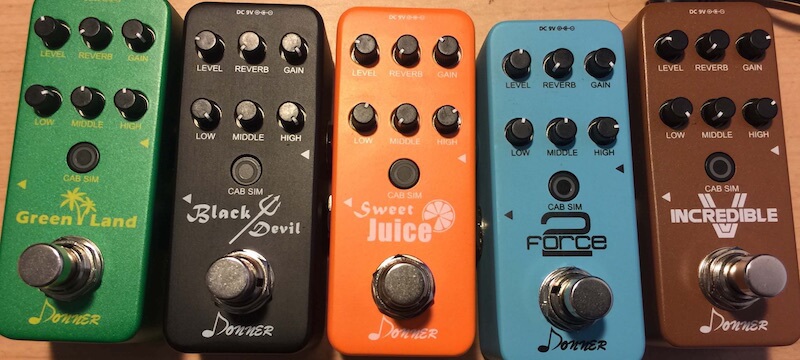
I love the versatility of these pedals. Clean, crunch, and heavy distortion plus reverb, and a cabinet simulator make these mini pedals like the swiss army knives of amp modeling pedals.
These pedals can be used in many situations like recording directly into a computer, re-amping, direct to a PA, or into a real amp. Let’s take a closer look. (See Figure 1 below for typical routing options)
YouTube Playlist Sound Demo Reviews:
Donner Force 2
The Donner Force 2 is based on the sound of a Soldano SLO 100. Channel A Clean – Based on Soldano SLO 100 Normal Channel, Channel B Crunch – Based on Soldano SLO 100 Overdrive Channel. See a detailed review here: Soldano SLO 100 Clone Donner Force 2 Mini Guitar Pedal Review.
Donner Black Devil
The Donner Black Devil A Peavey 6505 Clone Pedal (video demo) – Sound based on Peavey 6505. Channel A Crunch – Based on Peavey 6505 Rhythm Channel, Channel B Lead-Based on Peavey 6505 Lead Channel.
The Donner Green Land
The Donner Green Land pedal (video demo) is based on two different amps – Channel A is a clean sound based on a Fender Bassman and Channel B is a Crunch sound based on Marshall JTM45.
Donner Sweet Juice
Sounds based on Fender 65 Twin Reverb and an Orange AD30. CH A (Clean, green LED) – Based on Fender 65 Twin Reverb, CH B(Crunch, red LED) – Based on Orange AD30
Donner Incredible V
Sound-based on Fender 65 Twin Reverb* and Marshall Super Lead 1959
More Info & Where To Buy The Donner Preamp Pedals
Xvive Amp Modeling
Xvive Golden Brownie
The Golden Brownie is like a vintage Marshall JCM 800® in a box. If you want high gain hard rock ’80 tones then this is the pedal for you. The Golden Brownie features an easy to control gain function. It has an unbelievable (over) Drive range and is perfect for head-on heavy grind applications. The Pres (presence) knob adds versatile tweaking ability that transforms any amp into a fire-breathing hellhound! The Tone knob is all about the blues and soul. Turned down, it is time to rock, and turned up it is time to sing some blues.
Get The Xvive Golden Brownie Here
Joyo Amp Modeling Pedals
Out of all the Joyo amp modeling pedals I only own and tested the JF-14 American Sound, but I thought I would mention some of their other popular pedals as well.
The Joyo American Sound reproduces the sound of a Fender 57 Deluxe amp, which performs great from clean, driven, and everywhere in between.
Here’s an overview of other Joyo amp modeling pedals.
JF-13 AC Tone
The AC Tone pedal reproduces the sound of a Vox AC30 amplifier–that classic British rock sound all guitarists dream about.
JF-15 California Sound
Feel the sound of the Mesa Boogie MKII amplifier and get lots of natural and focused rock tones.
JF-16 British Sound
Get tones inspired by Marshall amps–everything from Bluesbreaker to Plexi Roar!
JF-17 Extreme Metal
With a powerfully adjustable 3 band EQ and sweep Mid-Freq knob, Extreme Metal provides a strong low frequency and clear, transparent high frequency. Play the rhythms and leads that cut through the mix!
Get the Joyo Amp Modeling Pedals Here
Mooer Micro Preamps
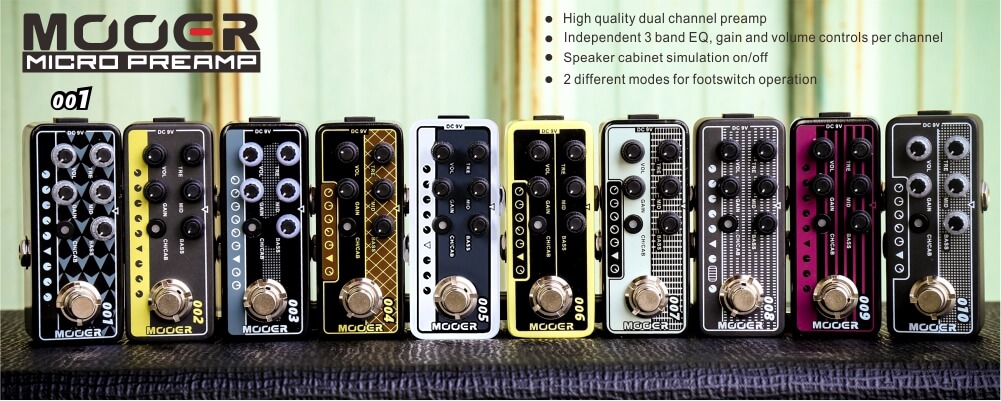 The MOOER micro preamps are sonically accurate digital recreations of the preamp sections of popular tube amplifiers. I have yet to try or review any of these pedals but wanted to include them in this list. These have almost exactly the same features as the Dooner ones I reviewed and mention at the top of this blog post.
The MOOER micro preamps are sonically accurate digital recreations of the preamp sections of popular tube amplifiers. I have yet to try or review any of these pedals but wanted to include them in this list. These have almost exactly the same features as the Dooner ones I reviewed and mention at the top of this blog post.
They have developed these by directly analyzing real tube amplifiers using a brand new technology to capture their sound, dynamics, and response. Each Micro Preamp comes complete with dual channels, integrated speaker cabinet simulation, and dual operating modes to suit the needs of all users.
Initially, Mooer released a set of 10 models, each based on a different popular tube amplifier from a range of manufacturers. These have been designed to be used with the upcoming MOOER power amp or in the effects return of any standard guitar amplifier. The speaker cab simulation allows the user to connect directly to a soundcard, powered monitor or P.A. without the need for a guitar amp or speaker cab at all.
Description of the Mooer Micro Preamps:
001. Gas Station Sounds based on a Diezel Hagen
002. UK Gold 900 – Based on the sounds of a Marshall JCM900
003. Power-Zone sounds based on a Koch Powertone
004. Day Tripper sounds based on a Vox AC30
005. Brown Sound 3 sounds based on an EVH 5150
006. Classic Deluxe sounds based on a Fender Blues Deluxe
007. Regal Tone sounds based on a Tone King Falcon
008. Cali-MK 3 sounds based on a Mesa Boogie MK III
009. Blacknight sounds based on an Engl Blackmore
010. Two Stone sounds based on a Two-Rock Coral
New Models
011. MOOER Micro Preamp 011(Cali-Dual)
012. (US GOLD 100)
013. MOOER Micro Preamp 013(Matchbox)
More Info And Where To Buy The Mooer Micro Preamps
Connect to a power amp or your amplifier’s effects return. (Highly recommend using a tube amplifier)
Different power amplifiers will affect the outcome of the final tone. You can also connect directly to a sound card and activate the speaker cab simulation for recording purposes
Note: You can connect your “fx loop” effects, like modulation and time-based effects, in between the MOOER preamps output and the input of the power amp (fx return)
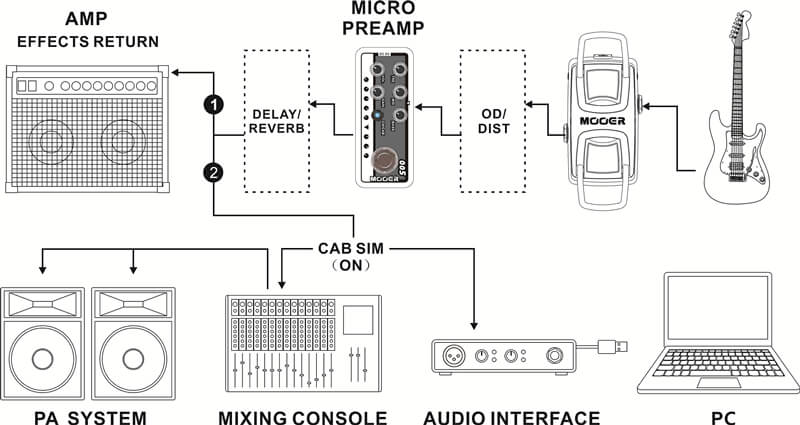
Let’s Not Forget A Cabinet Simulator
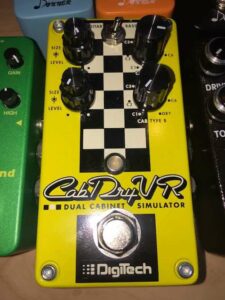
All the Donner and Mooer pedals I mentioned above have built-in cab sims, although it’s not said what cabinets they are modeled after if any. I really like the sound of them and they help keep things simple but I also want to mention another cool pedal I own, the DigiTech CabDryVR. I haven’t done a full review of this pedal yet but here is a brief description and some of the features.
The DigiTech CabDryVR Dual Cabinet Simulator pedal features a selection of 14 great sounding guitar and bass cab impulse responses. Now you can run directly from your pedal board or preamp through the CabDryVR to your mixing board, in-ear monitors or DAW and get high-quality cabinet emulation without the need for a real cabinet.
It’s another swiss army knife kind of pedal with 14 Guitar and Bass Cabinet Impulse Responses, Dual independent inputs and outputs, Separate level and Cabinet Tuning controls and of course True Bypass.
DigiTech CabDryVR Dual Cabinet Simulator cabinet models:
Guitar Cabinets: Vintage American 2×12″, Vintage British 2×12″, British Green Slant 4×12″ ,British Straight 4×12″, Heavy American 4×12″, Smooth Custom 4×12″, and Small Combo 1×8″
Bass Cabinets: Flexy 1×15″, Basic 1×15″, Big Blue 1×18″, AmeriTweed 4×10″, Gold Diamond 4×10″, Vintage Fridge 8×10″, and Blonde Basement 2×12″
Get The DigiTech CabDryVR Dual Cabinet Simulator Here
“We are a participant in the Amazon Services LLC Associates Program, an affiliate advertising program designed to provide a means for us to earn fees by linking to Amazon.com and affiliated sites.”
This review originally appeared on another website that I run that is no longer available.
Thoughts?
There are tons of Amp Modeling Pedals out there what are some of your favorites and which ones don’t you like, let me know in the comments below.
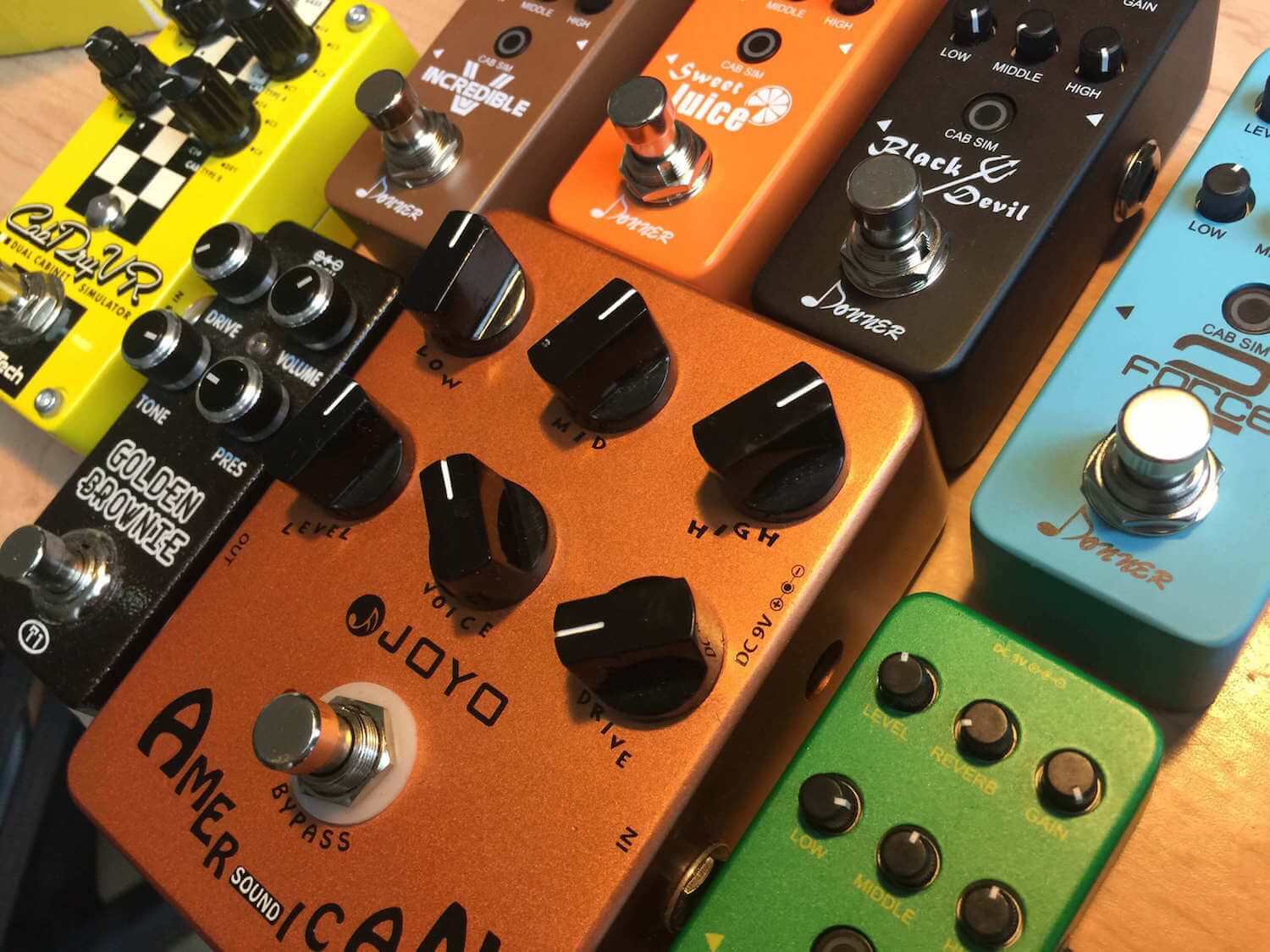
Leave a Reply